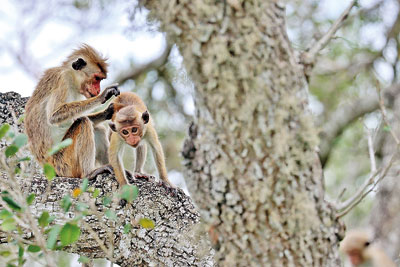News
Crop pest count has pluses and minuses
View(s):By Kasun Warakapitiya
Wildlife and agriculture experts and conservationists have mixed reactions to the proposed national census next Saturday of selected crop pests.
Some claim that out counting macaques and langurs, giant squirrels and peacocks in home gardens and cultivations would not solve the issue and is impractical, while others say gathering some information is useful due to the absence of information.
Experts also pointed out that even though the point census method is scientific, asking farmers and residents to count the animals will not help provide accurate information.
Leading primatologist as well as President of the Primatological Society of Sri Lanka (PSSL), Dr Jinie Dela explained that the census of monkeys by talking to householders is an impractical exercise.

To count or not to count monkeys
“As a primatologist who has carried out many home garden surveys, I can tell that five minutes or even taking more time is not a good way to get householders to count arboreal monkeys.”
The probability of getting a vastly inflated number is inevitable, she said. “How can home garden owners prevent double counting and know whether they counted the same monkey again and again. This is why we use trained persons when carrying out any monkey census,’’ she said.
“We from the PSSL could provide our knowledge and work with the ministries concerned to more realistically address the human-monkey conflict and to mitigate or reduce it. Quick fixes are, however, not possible when we have delayed taking action for years, while also promoting our country as a popular ecotourism destination.’’
The agriculture and environment ministries should work together with the relevant departments and primate experts as well as administrators and local people to resolve matters.
Some experts believe that learning about the number of animals is productive as it helps authorities to act, but, using laymen to gather data could cause biases.
Senior Professor at the Department of Crop Science at the Faculty of Agriculture at University of Peradeniya, Buddhi Marambe told the Sunday Times even though there are many defects, the census would be useful as currently there is no statistical data available on wild animals that damage crop.
“Sometimes, having something is better than having nothing, in this case that is partly true because we do not have any information about those animals. So the information matters as it would give some idea about the animals,’’ he said
But, data accuracy would be questionable.
Prof Marambe said the manner in which the data is presented and interpreted is crucial as that would be the basis for the analysis. Wildlife experts should carry out the analysis as they are knowledgeable of animal group structures, behaviour and migration.
Environmental activist and researcher, Supun Lahiru Prakash pointed out that even though he does not see serious issues with the methodology, he is concerned about how the information will be used.
He said that the method is used worldwide, and in any scientific method there are both pros and cons. In this case, the challenge is accuracy as untrained Sri Lankans are collecting data.
Mr Prakash explained that state authorities and government have a habit of using the data from nationwide surveys to justify their faults and their action plans and to affirm claims made by them.
He said that there is a history of Sri Lankan authorities misusing science to carry out political agendas and to cover-up their inadequacies. For instance, the national elephant survey by the Department of Wildlife Conservation in 2011 was used to claim there are too many elephants.
Some conservationists and senior state officials said that authorities and people should look into the causes which attract animals into human habitation and cultivation zones and set up mechanisms to prevent animals from venturing into homes and plantations.
Meanwhile, a senior official of the Ministry of Agriculture said that the government would use data to manage pest animals through sterilisation, translocation or culling.
The official also pointed out the census would also be used as the basis to justify government actions to international conventions, unions and other organisations where previous governments had signed agreements and obtained memberships.
Hemantha Aamarasinghe, Director (agriculture technology) of the Ministry of Agriculture told the Sunday Times that the census would be islandwide.
He said that Grama Niladhari officers Samurdhi Development Officers, Economic Development Officers and Agriculture Research and Production Assistants were instructed to hand out forms census forms.
The result would be used to create result sheets at divisional secretary level and district secretaries would collect that and submit the district results to the Agriculture Ministry.
He is also a member of the Special Committee for Reducing Damages Caused by Wild Animals (SCRDCWA). He said the data recorded would be sent to the Agriculture Ministry via divisional secretariats.
Mr Amarasinghe said a trial was done in a village in the Ingiriya area. The exercise should be repeated and an average should be calculated if more accurate figures are needed.
However, the General Secretary of the All Island Free Grama Niladhari Union, Jagath Chandralal complained that a census which should be done jointly by the Ministry of Wildlife, Ministry of Agriculture, Forest Department, and Department of Census and Statistics had been forced on them.
He said that the Grama Niladhari and other three state officers had not been given any directive, guidelines on how to instruct people to carry out the census. Mr Chandralal said the forms had been handed out but most of the Grama Niladhris have not received them.
He said this will not work. “We request the government not to blame us if this census fails.’’
Director In charge of Wildlife Health of the Department of Wildlife Conservation (DWC) Dr Tharaka Prasad who is also a member of the SCRDCWA said that the time limit of five minutes was imposed to avoid re-counting of animals.
He said that statistics are needed to find solutions against the damage done by the monkey, giant squirrel, and peacock. “Without knowing numbers we cannot know whether we have an excess or fewer animals.’’
Agriculture Ministry Secretary, D.P Wickramasinghe said that the census is needed to understand about animals that frequent human habitation and cultivations. The data will help inform decisions.
| Head count will raise awareness of pests and test estimates A renowned primatologist says there are positives in the monkey head count. Dr Wolfgang Dittus, visiting research professor at the National Institute of Fundamental Studies, as well as a research associate of the Smithsonian’s National Zoo and Conservation Biology Institute, said the census would generate interest among people in the wild animals in their neighbourhoods. Assuming that counts are reliable, it would test our more than 50 years of observations that monkeys are conspicuous in large numbers at locations where they have easy access to food and/or water, he said. And finally, it may shed light on the wildly unreliable recent estimates of the monkey population. Dr Dittus who is also director of the Association for the Conservation of Primate Diversity said this differs from people’s antagonistic attitude towards pest animals. “Our experienced primatologists report that when monkeys damage property, people grossly exaggerate the number of monkeys to draw attention to their plight. The weak link is the attitude and ability of the counter that introduces skepticism to an otherwise sound method.’’ The rationale of the census is to provide authorities with data on which to base remedies to reduce human-monkey conflict (HMC). The statistics have application insofar as they may pinpoint locations where monkeys are concentrated, and this serves as a follow-up to investigating the cause. “We already know that monkey concentrations occur where human food is available in the environment. Authorities might then follow up and give remedies,” he said. On the other hand, the statistics have limited use to the strategies of reducing HMC. Instead, people need to know how to protect their properties from damage caused by even a single monkey. The focus therefore, should be protective measures, not the number of monkeys. The basis of that objective is education. The question arises as to what the authorities intend to do with the census numbers? A popular misconception is to trap monkeys, remove them from trouble spots, and release them in rural or protected areas. The plan fails to recognise that resident monkeys in protected areas already occupy all available suitable habitat, they are territorial xenophobes that kill translocated refugee monkeys. In addition, streetwise monkeys from towns have lost their tradition of forest feeding, and upon release they seek the nearest village that in their lifelong experience has been the basis of their livelihood. | |
The best way to say that you found the home of your dreams is by finding it on Hitad.lk. We have listings for apartments for sale or rent in Sri Lanka, no matter what locale you're looking for! Whether you live in Colombo, Galle, Kandy, Matara, Jaffna and more - we've got them all!

